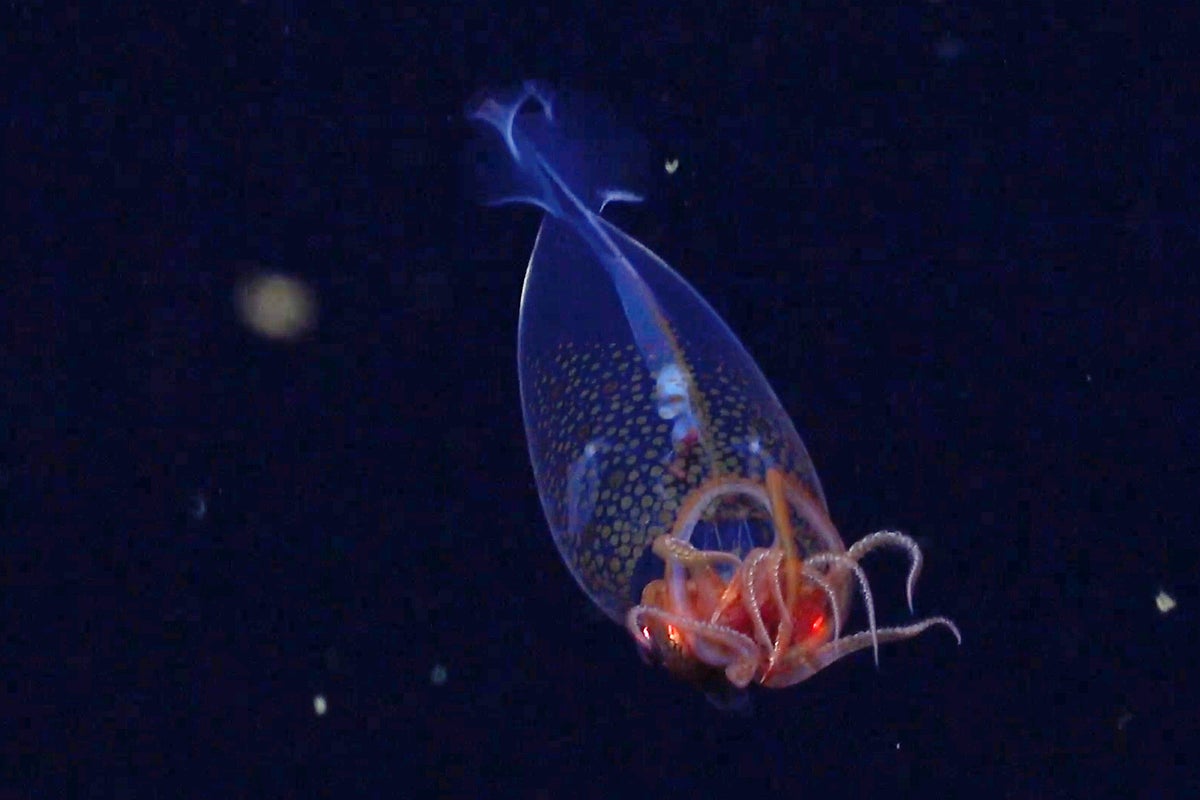This Is the First Colossal Squid Filmed in the Deep Sea—And It’s a Baby!
A colossal squid was filmed for the first time in its natural habitat near the South Sandwich Islands during a recent expedition, and it turned out to be a baby
This is the first confirmed live observation of the colossal squid (Mesonychoteuthis hamiltoni) in its natural habitat, taken by the remotely operated vehicle SuBastian on March 9 during an Ocean Census flagship expedition in the remote South Sandwich Islands in the South Atlantic Ocean. This squid is a baby about one foot long.
Join Our Community of Science Lovers!
A faintly fluttering specter, at first hardly visible among bits of marine snow falling in slow motion, emerged from the deep-sapphire void. The pilot of the underwater robot brought the creature to the center of the frame, giving scientists on a ship at the ocean’s surface a good view of the strange life-form. Its mostly transparent, speckled dome was topped with fins that busily flapped like tiny wings, and its tentacles were drawn up underneath it, toward its glowing red undercarriage.
There was little fanfare—just a few minutes of quiet, almost reverent observation. But the encounter, 100 years in the making, marked the first time a colossal squid (Mesonychoteuthis hamiltoni) had ever been caught on film in its natural habitat.
If you’re enjoying this article, consider supporting our award-winning journalism by subscribing. By purchasing a subscription you are helping to ensure the future of impactful stories about the discoveries and ideas shaping our world today.
Scientists onboard the Schmidt Ocean Institute’s research vessel Falkor (too) saw the colossal squid about 2,000 feet beneath the surface near the remote, uninhabited South Sandwich Islands in the South Atlantic Ocean. These leviathans can grow to about 23 feet long and can weigh more than 1,000 pounds—shorter, but much stockier, than the giant squid (Architeuthis dux), which grows to about 43 feet long and 600 pounds. The colossal squid that was captured on film was just a baby, however, measuring only about a foot in length.
“It’s incredible that we can leverage the power of the taxonomic community through R/V Falkor (too) telepresence while we are out at sea,” said the expedition’s chief scientist, Michelle Taylor of the University of Essex in England, in a recent press release. “The Ocean Census international science network is proud to work together with the Schmidt Ocean Institute to accelerate species discovery and expand our knowledge of ocean life, live online with the world’s science community.”
Though people have known about the existence of colossal squids for a century, the animals had mainly been found among the stomach contents of whales and seabirds, successfully evading human eyes in their natural habitat.
“Much of our scientific and filming gear is noisy and bright, so squid will be aware of our equipment long before we know they’re there—and they will stay well away,” Bolstad says. “The deep sea is a vast 3D space, and looking for specific animals there is tricky, especially when they are probably actively trying to avoid us!” Scientists still don’t know much about what these reticent creatures feed on, how long they live or what their reproductive traits are.
The sighting came alongside many other strange encounters, including a grenadier fish with parasitic pigtails, a piñatalike anemone, a carnivorous sponge that resembled a dandelion and Seussian corals. In a region so remote and underexplored, it’s no surprise that weird and wonderful discoveries emerge—and each new find offers valuable insight into a world that science is still just beginning to understand.
“Observing the colossal squid gives us the chance both to learn about this remote place,” Bolstad says, “and to share the excitement of such discoveries with people who may not think about the deep sea very often—even though it makes up 95 percent of the living space on Earth and plays an enormous role in regulating our climate.”
Ashley Balzer Vigil writes about astrophysics for NASA’s Goddard Space Flight Center by day and moonlights as a freelance environmental writer.
Source: www.scientificamerican.com
